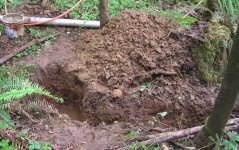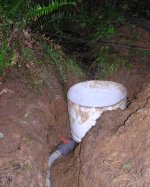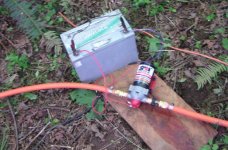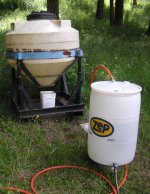Ok,
I've made some progress on the spring.
Against some of the advice here, I decided to leave the origin of the spring (stump) alone, and to design a simple surface catchment just below the spring.

Mostly dug out. By planning on a drain at the bottom of my tank, I was able to dig a ditch downhill which kept my hole mostly dry.

Barrel and drain pipe placed. 2" bung to a somewhat sweeping 90 degree turn to valve. The valve was "recycled". I removed a T from the valve, and machined the shoulder to match my 2.5" drain pipe & 45 degree sweep (also mostly recycled).

Backfilled. Fiberglass pipe for valve access. As I was testing everything for leaks, and backfilling, I added a small dam and pipe to direct the water. A small percent works its way around the dam, but I've left the pipe in place for now.
I made a tripod to hold the float and inlet pipe. The "foot" has a built in one-way valve.
I think the orange poly pipe is 3/4". It was cheap. However, it seems to match 1" PEX hose barbs best.
I have one of those free floating float valves with the ball inside. Unfortunately, I discovered that it only works with the float ball adjusted to go nearly vertical before engaging. I had several adjustments including a cheese-block mount for it onto my tripod.

12V pump.
This one came from Northern Tools.
NorthStar NSQ Series 12V On-Demand Diaphragm Pump 2.2 GPM @ 70 PSI | Sprayer Pumps| Northern Tool + Equipment
I've connected everything with brass fittings and hose clamps, so that the clamps can be easily separated. They had a quick connect option, but I thought the hose ends would suit my needs better.
One thing I discovered, if the pump looses prime, then it is unable to blast air uphill into an uphill pipe filled with water. So, one must bleed the uphill pipe while re-priming the pump. As it is, I close the valve and disconnect, but perhaps adding a "Y" with valves would be easier if I need to do this very frequently.
Otherwise, this seems to pump a little faster than my spring flow which was what I had intended. It gets warm on use, so intermittent is probably better than continuous duty.
It draws about 6 to 7A.
I Goofed on my first pump. Beware of some pumps advertising different systemic pressure vs pressure generated by the pump. I got one with a 110 psi systemic pressure rating, but only something like a 10 foot head rating.

ZEP at the top of the hill.
I need to put a seal and some fittings on the bottom of my cone bottom tank. However, I'm trying to decide if I wish to purchase a larger tank. Poly? Steel? Stainless? 1500 gallons should catch about one full day worth of water. A couple thousand gallons for several days of water.
So far, I've been turning it off when not in use, but I plan to plumb an overflow to water some trees, and pump continuously.
I would like the tanks to function as a fire backup. I don't know if poly would hold up if it caught on fire (perhaps it would just burn to the water level).
Things left to do:
- Add solar panels. Currently the system is being run with a trickle charger and several extension cords.
- Bury all of the pipes.
- Bigger tank?
- More tank elevation?
- I'll watch it some. If debris becomes a problem, then cover everything.
I'm still trying to decide if I want to cross-connect to my well and house. The well pump has been on the fritz for a few days now.




